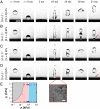Superhydrophobic surfaces for extreme environmental conditions
- PMID: 33077603
- PMCID: PMC7959546
- DOI: 10.1073/pnas.2008775117
Superhydrophobic surfaces for extreme environmental conditions
Abstract
Superhydrophobic surfaces for repelling impacting water droplets are typically created by designing structures with capillary (antiwetting) pressures greater than those of the incoming droplet (dynamic, water hammer). Recent work has focused on the evolution of the intervening air layer between droplet and substrate during impact, a balance of air compression and drainage within the surface texture, and its role in affecting impalement under ambient conditions through local changes in the droplet curvature. However, little consideration has been given to the influence of the intervening air-layer thermodynamic state and composition, in particular when departing from standard atmospheric conditions, on the antiwetting behavior of superhydrophobic surfaces. Here, we explore the related physics and determine the working envelope for maintaining robust superhydrophobicity, in terms of the ambient pressure and water vapor content. With single-tier and multitier superhydrophobic surfaces and high-resolution dynamic imaging of the droplet meniscus and its penetration behavior into the surface texture, we expose a trend of increasing impalement severity with decreasing ambient pressure and elucidate a previously unexplored condensation-based impalement mechanism within the texture resulting from the compression, and subsequent supersaturation, of the intervening gas layer in low-pressure, humid conditions. Using fluid dynamical considerations and nucleation thermodynamics, we provide mechanistic understanding of impalement and further employ this knowledge to rationally construct multitier surfaces with robust superhydrophobicity, extending water repellency behavior well beyond typical atmospheric conditions. Such a property is expected to find multifaceted use exemplified by transportation and infrastructure applications where exceptional repellency to water and ice is desired.
Keywords: droplet impact; superhydrophobic; wetting.
Conflict of interest statement
The authors declare no competing interest.
Figures






Similar articles
-
Imparting Icephobicity with Substrate Flexibility.Langmuir. 2017 Jul 11;33(27):6708-6718. doi: 10.1021/acs.langmuir.7b01412. Epub 2017 Jun 28. Langmuir. 2017. PMID: 28609620
-
Hybrid surface design for robust superhydrophobicity.Langmuir. 2012 Jun 26;28(25):9606-15. doi: 10.1021/la301743p. Epub 2012 Jun 6. Langmuir. 2012. PMID: 22630787
-
Transparent Photothermal Metasurfaces Amplifying Superhydrophobicity by Absorbing Sunlight.ACS Nano. 2020 Sep 22;14(9):11712-11721. doi: 10.1021/acsnano.0c04365. Epub 2020 Aug 28. ACS Nano. 2020. PMID: 32794696
-
Bioinspired super-antiwetting interfaces with special liquid-solid adhesion.Acc Chem Res. 2010 Mar 16;43(3):368-77. doi: 10.1021/ar900205g. Acc Chem Res. 2010. PMID: 19954162 Review.
-
Mimicking natural superhydrophobic surfaces and grasping the wetting process: a review on recent progress in preparing superhydrophobic surfaces.Adv Colloid Interface Sci. 2011 Dec 12;169(2):80-105. doi: 10.1016/j.cis.2011.08.005. Epub 2011 Sep 14. Adv Colloid Interface Sci. 2011. PMID: 21974918 Review.
Cited by
-
Durable superhydrophobic surface in wearable sensors: From nature to application.Exploration (Beijing). 2023 Nov 8;4(2):20230046. doi: 10.1002/EXP.20230046. eCollection 2024 Apr. Exploration (Beijing). 2023. PMID: 38855620 Free PMC article. Review.
-
Preparation and Characterization of Modified ZrO2/SiO2/Silicone-Modified Acrylic Emulsion Superhydrophobic Coating.Materials (Basel). 2023 Dec 13;16(24):7621. doi: 10.3390/ma16247621. Materials (Basel). 2023. PMID: 38138763 Free PMC article.
-
Moisture-resistant MXene-sodium alginate sponges with sustained superhydrophobicity for monitoring human activities.Chem Eng J. 2022 Mar 15;432:134370. doi: 10.1016/j.cej.2021.134370. Epub 2022 Jan 6. Chem Eng J. 2022. PMID: 35110969 Free PMC article.
-
Covalent crosslinking chemistry for controlled modulation of nanometric roughness and surface free energy.Chem Sci. 2024 Feb 19;15(13):4938-4951. doi: 10.1039/d3sc06077b. eCollection 2024 Mar 27. Chem Sci. 2024. PMID: 38550695 Free PMC article.
-
Self-cleaning of superhydrophobic nanostructured surfaces at low humidity enhanced by vertical electric field.Nano Res. 2022;15(5):4732-4738. doi: 10.1007/s12274-022-4093-0. Epub 2022 Feb 8. Nano Res. 2022. PMID: 35574261 Free PMC article.
References
-
- Quéré D., Non-sticking drops. Rep. Prog. Phys. 68, 2495–2532 (2005).
-
- Barthlott W., Neinhuis C., Purity of the sacred lotus, or escape from contamination in biological surfaces. Planta 202, 1–8 (1997).
-
- Boreyko J. B., Chen C.-H., Self-propelled dropwise condensate on superhydrophobic surfaces. Phys. Rev. Lett. 103, 184501 (2009). - PubMed
-
- Cassie A. B. D., Baxter S., Wettability of porous surfaces. Trans. Faraday Soc. 40, 546–551 (1944).
Publication types
LinkOut - more resources
Full Text Sources
Other Literature Sources

